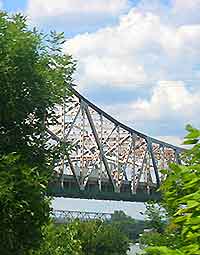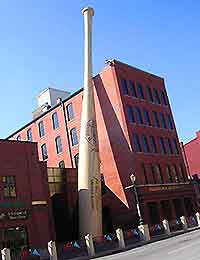Louisville History Facts and Timeline
(Louisville, Kentucky - KY, USA)

The human habitation history of the city of Louisville goes back some 3,000 years due to its strategic location on the Ohio River's rapids, beyond which river travel is not possible by boat loads too heavy for portage.
Early European arrivals in Louisville included French explorer Rene-Robert Cavalier in 1669 and later, British colonist Christopher Gist. After Cavalier's visit, the region was claimed for
France, but following the defeat of the French in the French and Indian War (1754 to 1763) it was ceded to
England.
Pioneer Days and the War of Independence
Pioneer Daniel Boone arrived in the area in 1771 and was followed two years later by Captain Thomas Bullitt on behalf of French Virginians, who were granted land for their service in the French and Indian War. Earlier incursions were forced to retreat by local Native Indian tribes. By 1778, during the American War of Independence (1775 to 1783), Colonel George Rogers Clark founded an Anglo-American settlement, mainly for military purposes, which was destined to become Louisville.
In those early days of Louisville history, settlers lived in forts that protected them against raids by Native American Indian tribes, with the first fort located north of Louisville's present-day Main Street. Fearful of attacks by British forces, the settlers built a larger, stronger fortification on an acre of land close by. The town charter was approved and a street plan laid out by 1789, resulting in the arrival of some 300 pioneer families and the construction of homes, a church, a hotel and a post office. Due to a complicated land dispute, Spanish trade restrictions on the Mississippi River and further Indian attacks, growth was slowed until the early 19th century.
Shipping Solutions
By 1810, most shipping on the Ohio River was still one-way traffic downstream, due to the river's falls and rapids. It thrived initially by supplying the portage logistics. The advent of steamboats in 1811 changed the rules of the game, as the boats were not only fast, they were able to make the upriver journey against the current, and even over the rapids. The Enterprise, captained by Henry Miller Shreve, was the first steamboat to run from
New Orleans to Louisville and by 1825, the digging of the Louisville and Portland Canal allowed ships to bypass the falls altogether.
The commercial potential of the steamships and the canal brought manufacturing and industry, with development continuing apace. A hospital, several schools and the famed downtown Galt House Hotel were all up and running by 1834. Another much-loved Bluegrass sector, horse breeding, was about to spring into prominence, with the precursor of the Kentucky Derby first held in 1839. Subsequently, Louisville became the Kentucky hub for horse sales and breeding stables, contributing hugely to the local economy. By 1859, the railroad had arrived, cementing the city's important position in the state.

Civil War, Horses and Disasters
During the Civil War (1861 to 1865), the city was a Union stronghold with an army base headed up by General William Tecumseh Sherman. Surrounded by battles and skirmishes, Louisville wasn't attacked once during the war, although returning Confederates grabbed most municipal political positions.
With the war over, the city turned to lighter pursuits, with the Kentucky Derby, first run in 1875, drawing roughly 10,000 spectators. The following year saw the forging of the city's ongoing link with professional baseball. A successful five-year World's Fair followed in 1883, although one of the worst tornadoes in the history of Louisville flattened huge swathes in 1890, and the Great Flood of 1937 submerged 70 percent of the city.
WWII and Onwards
An important center for the manufacture of military supplies during WWII, the city of Louisville fell into decline in the post-war period, with depopulation of the downtown area resulting from rapid suburban business and residential development.
Renaissance began in the 1970s with the renovation of heritage buildings and new construction, and the Ohio River Falls was granted Federal conservation status, although the city struggled well into the 1990s. Nowadays, culture and the arts are flourishing and visitor numbers to the Victorian architectural treasures in the Old Town are steadily increasing.
 The human habitation history of the city of Louisville goes back some 3,000 years due to its strategic location on the Ohio River's rapids, beyond which river travel is not possible by boat loads too heavy for portage.
The human habitation history of the city of Louisville goes back some 3,000 years due to its strategic location on the Ohio River's rapids, beyond which river travel is not possible by boat loads too heavy for portage.